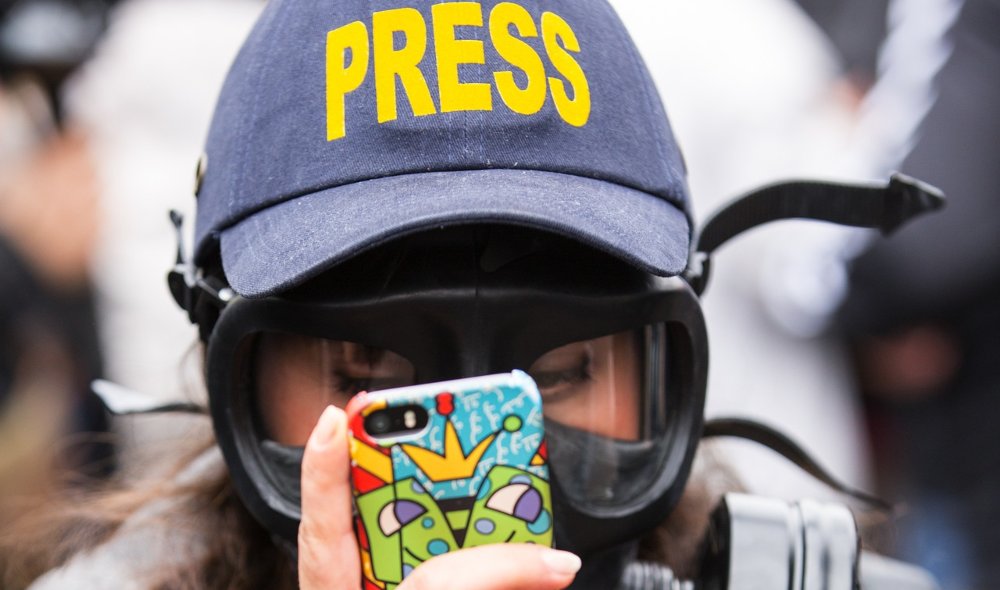I remember my first press pass. As a college student working for the Associated Press during the summer, I proudly wore that pass around my neck in New York City. The little piece of plastic got me past police lines and gave me entrée to places where I could be the eyes and ears of the public.
At Post Alley, we don’t have press passes. And these days, I might hesitate to wear one if offered. I’m still proud to be a journalist, but the once-coveted pass has become more of a bullseye than an asset.
The public has increasingly lost trust in the media. Gallup reported last month that a record nearly four in 10 Americans say they completely lack confidence in the media. This coincides with an increase in physical attacks on reporters. Organizations like the Committee to Project Journalists document the unprecedented number of journalists being killed or assaulted around the world with the number spiking with the recent tragic events in Gaza.
Domestically, we witnessed vicious physical attacks on reporters covering the January 6, 2021 riots in Washington, D.C. and related violent gatherings across the country. In a previous Post Alley article, I wrote about that violence and how reporters in Olympia were threatened.
It’s anticipated as the 2024 election looms closer that journalists covering the races will once again be in the crosshairs. In response, safety training is now increasingly commonplace for newsrooms and reporters. This week, the International Women’s Media Foundation (IWMF) announced the launch of a new initiative to bring journalism safety training to local newsrooms around the country.
“Many U.S. newsrooms, which are frequently underserved and under-resourced, were caught off-guard by the spike in physical and digital violence directed against them,” said Elisa Lees Muñoz, executive director of the IWMF. “The Newsroom Safety Across America initiative will help newsrooms better prepare for, respond to, and recover from threats so that no journalist has to bear the weight of an attack alone.”
The IWMF this year already has trained 658 journalists on risk assessment, personal security, legal protection, mental health care, and more. The Committee to Protect Journalists, Radio Television Digital News Association, Society of Professional Journalists and a number of other journalism organizations also offer safety programs. If you question the need for such training, consider that the IWMF reported that this year alone, 30 journalists have been assaulted and eight have been arrested in the U.S. The U.S. currently ranks 45th on the World Press Freedom Index.
Even student journalists are considered at risk. The journalism department at Marquette University, for example, partnered with the James W. Foley Foundation to develop safety modules. “The modules are intended to help educators create a culture that promotes safety for all journalism and communications students,” the announcement said. “The 13 safety modules cover such topics as completing risk assessments, responsibilities of newsroom managers, safety of female and minority journalists, covering civil unrest, emotional self-care, care of sources, interviewing hostile sources, reporting on foreign conflicts, protecting digital data, dealing with online harassment, covering weather-related stories, and reporting during the current pandemic. The safety modules are intended to challenge and inform aspiring journalists in an increasingly dangerous world.”
When I taught journalism at Georgetown University, such safety concerns had not yet risen to this level. We would talk in general about staying safe when on dangerous assignments, but did not anticipate that practicing local and political journalism would become increasingly a battlefield assignment.
Safety training may be as essential for journalists now as other basic tools of the trade like cell phones and laptops. But we also have to keep asking how we got to this point, why there so much distrust of the media. And most important, what can we do to regain the trust of the public we seek to serve?
Discover more from Post Alley
Subscribe to get the latest posts sent to your email.

Thank you, Linda, for a timely reminder of the risks faced by journalists. There has ever been the “kill the messenger’ undercurrent. It is even more apparent in this polarized Trump era when hostility is no longer restrained. I fear for journalists everywhere. We need to do whatever steps we can to protect the men and women who are our truthtellers.
Nothing but respect for journalists.
To be honest, however, an increasing number include their personal opinion or bias in “news stories.”
I read that claim all the time in the Seattle Times comments, though when challenged, rarely if ever is anyone able to back it up.
Anyway, just to be clear about implications – journalists can reasonably expect threats to their persons, if their articles are perceived to include personal bias, is that right?
Thank you Linda for this update on the risks to journalists who risk violence and even death in the course of their work to bring news of the world to the public. The war on the press has only worsened in the past decade. Indeed, as of today, November 21, the Committee to Protect Journalists reported that more than 50 members of the press have died in the Israel-Hamas War—that’s just in the past six weeks in one isolated conflict. Here’s a link to the heartbreaking CPJ report. https://cpj.org/2023/11/journalist-casualties-in-the-israel-gaza-conflict/
Thanks for the link. So very tragic. Journalists in war zones have increasingly become targets. How can the public stay informed, which is one of the basic tenets of democracy, if reporters are attacked while trying to cover the news both here and abroad? While it’s crucial that journalists work to build trust through transparency and more open dialogue and other forms of outreach, for the foreseeable future their work will continue to be put them at risk.